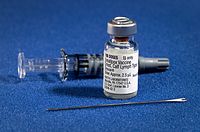
Photo from wikipedia
Objective This study was designed to evaluate the operability, effectiveness, and safety of the automated titanium suture fastener in a preclinical ovine model in comparison with manual tying in a… Click to show full abstract
Objective This study was designed to evaluate the operability, effectiveness, and safety of the automated titanium suture fastener in a preclinical ovine model in comparison with manual tying in a mitral valve annuloplasty ring implantation surgery. Methods Eighteen adult Small-tailed Han sheep were prepared for the surgery of mitral valve annuloplasty ring implantation through lateral thoracotomy under cardiopulmonary bypass (CBP). A total of 12 stitches were performed to secure an annuloplasty ring, with 6 stitches done with the automated fastener and the other 6 by manual tying. The knotting time for the automated fastener or manual tying was recorded, respectively. The firmness of knots, mitral valve integrity, biocompatibility, thrombosis, local reactions, and other aspects were also compared at follow-up time (Days 30, 60, 90, and 180). Results Of the 18 sheep, 16 survived to the designated endpoints and were enrolled for further analysis. Compared with the control group, the knotting time was significantly reduced with the automated fastener (p < 0.01). All the annuloplasty rings were tightly secured by 6 fastener clips and 6 hand-made knots without any disengagement or displacement. All the mitral valves were intact without any defect, stenosis, prolapse, valve insufficiency, or perforation. Endothelialization was comparable between the two groups by Day 60. Small red thrombi formed at the thread end of the suture in both groups. No thrombus was found on the surface of the titanium clip. All the thrombi were within the acceptable range for the antithrombotic property. Thrombosis showed no significant difference by Day 60. No significant differences in the inflammatory response and pathological lesions were observed by Day 60. One case of diffuse renal infarction (area ratio = 20%) and 1 case of small focal renal infarction (area ratio < 5%) were caused by thromboembolism. Conclusions The automated fastener significantly shortened the procedure time of tying knots for the implantation of the annuloplasty ring in the ovine model, with comparable safety and effectiveness as manual tying.
Journal Title: Frontiers in Cardiovascular Medicine
Year Published: 2022
Link to full text (if available)
Share on Social Media: Sign Up to like & get
recommendations!